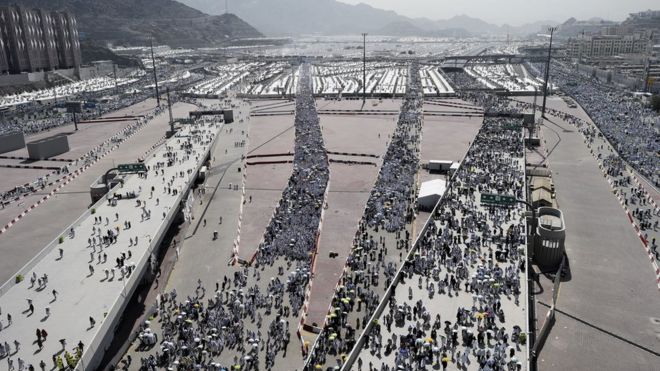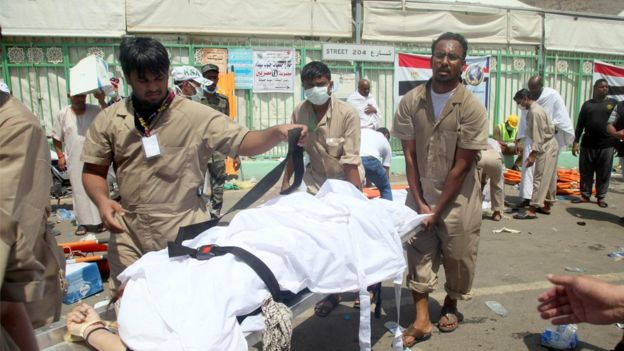Hajj stampede: What we know so far
- 25 September 2015
- Middle East
 Getty Images
Getty Images
More than 700 pilgrims have been killed and at least 860 injured in a stampede during the annual Hajj near the holy city of Mecca.
Saudi authorities have launched an investigation into how the tragedy happened, but here are the facts that have emerged so far.
When and where did it happen?
Saudi civil defence officials say the crush happened at about 09:00 local time (06:00 GMT) on Thursday at the intersection of streets 204 and 223 in Mina, a large valley about three miles east of Mecca.
Pilgrims had been walking from a tented area towards a large structure overlooking the Jamarat pillars where the symbolic stoning of the devil is carried out.

What caused the crush?
A spokesman for the Saudi interior ministry, Maj Gen Mansour al-Turki, said initial reports indicated that two crowds coming from opposite directions converged at the intersection of streets 204 and 223 and people started to push and to shove.
What is not yet clear is how that could have happened. Some unconfirmed accounts say a nearby street or path had been closed, forcing those heading to the ritual site to use the same route as those leaving.
Saudi Health Minister Khaled al-Falih appeared to lay at least some of the blame on the pilgrims themselves, suggesting some had "moved without following instructions by the relevant authorities". Iran, however, has urged the Saudi government to accept responsibility.
Witnesses said temperatures were very hot at the time, which may have contributed to the panic.
The street where the crush happened is said to be about 12m (36ft) wide with tall gates on both sides, behind which are the tents of Hajj tour groups.
 Getty Images
Getty ImagesWhere were the victims from?
Those who died are reported to be from a wide range of nationalities but those confirmed so far are: Iran (131); India (14); Pakistan (6); Turkey (4); Indonesia (3); Kenya (3), Egypt (8).
There are also victims from Niger, Chad, Algeria and Morocco but the numbers are not yet confirmed. Afghanistan has said at least eight of its pilgrims are missing.
 Reuters
ReutersWhat safety procedures are in place for the Hajj?
Saudi authorities have spent billions of dollars on improving transport and other infrastructure to try to prevent deadly incidents at the Hajj.
Thursday's crush happened away from the five-storey Jamarat Bridge which was completed in 2007 at great expense and was intended to improve safety.
About 5,000 security cameras are in place around Mecca and Medina and Saudi authorities deployed about 100,000 security personnel for this year's event.
Faced with growing numbers for the annual Hajj, Saudi Arabia has also been working for four years on an enlargement at the Grand Mosque.
However, it was there earlier this month that a crane toppled over during a storm, killing more than 100 people.
- Hajj pilgrim 'very scared'
- UK families await news
- BBC reporter at Hajj: 'My aunt is missing'
- Accounts from Mecca
- Hajj's safety concerns
- Timeline: Deadliest stampedes
- Hajj crush: Day's events
- In pictures: Aftermath of stampede at Hajj pilgrimage
- Hajj in numbers - in 60 seconds
- Hajj stampede: UK 'ready to help' Britons in Mecca
- Mecca crane collapse: Saudi inquiry into Grand Mosque disaster
- Saudi Arabia country profile
No comments:
Post a Comment
Please leave a comment-- or suggestions, particularly of topics and places you'd like to see covered